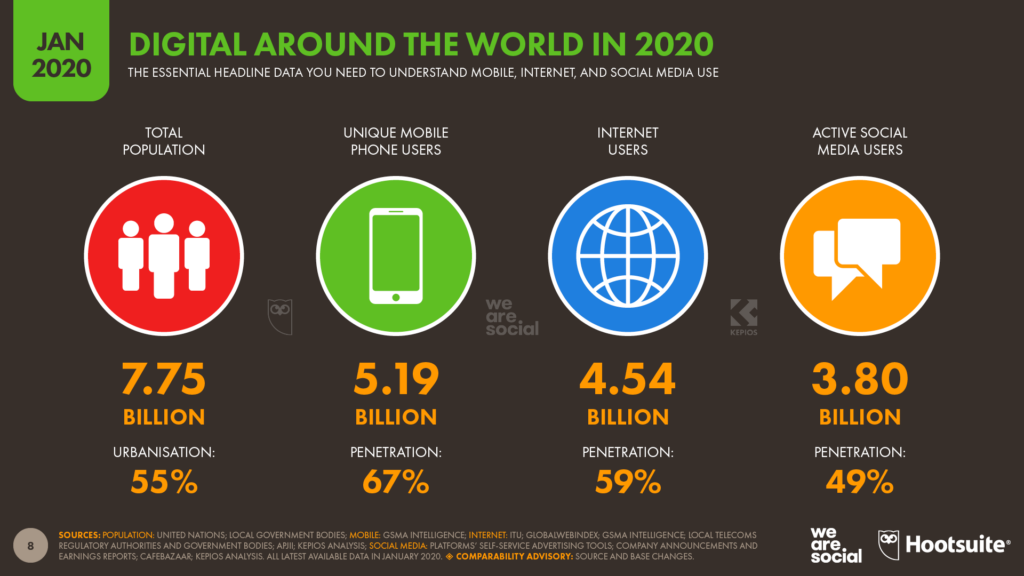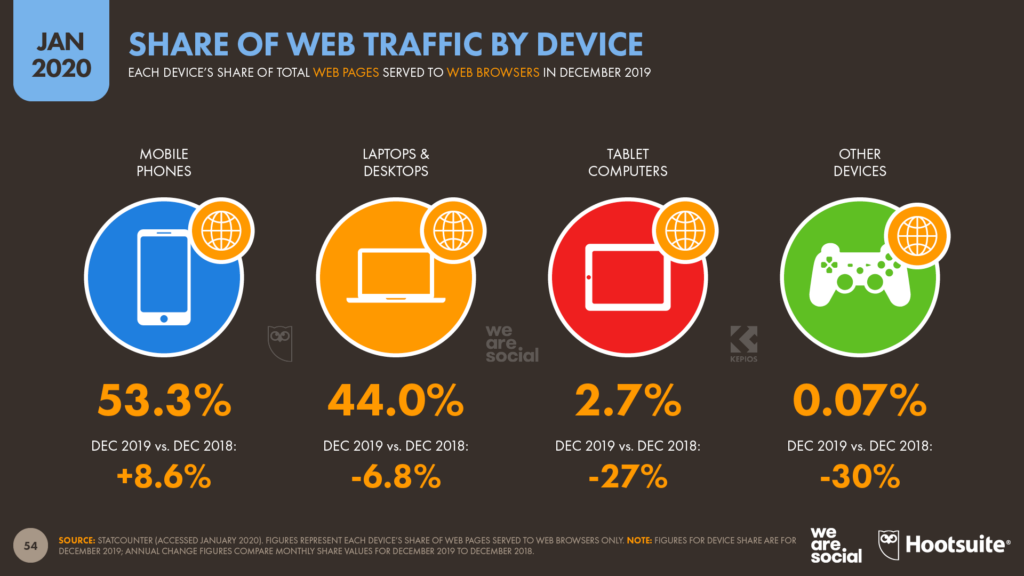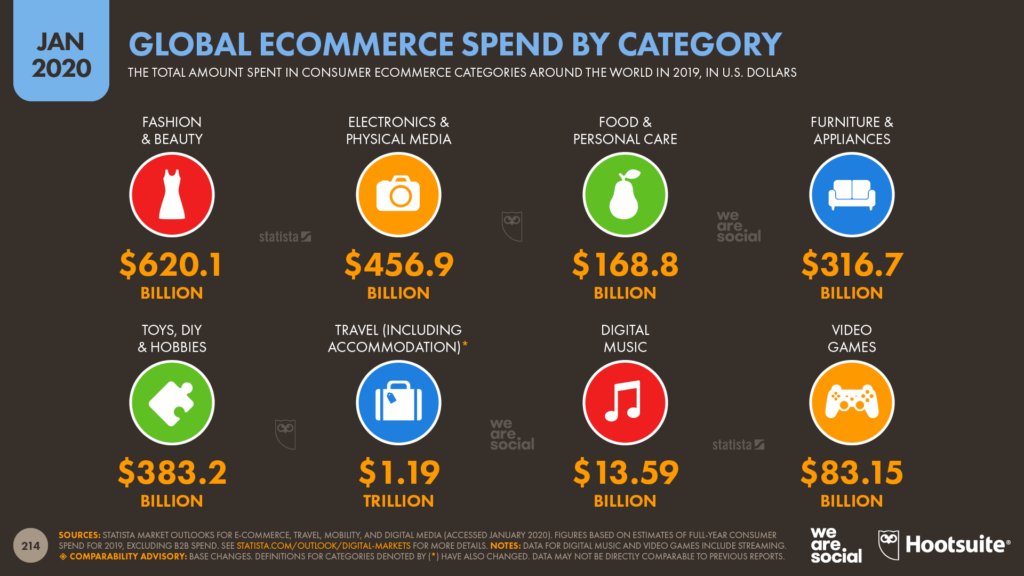In a comprehensive LinkedIn SlideShare, Hootsuite and We Are Social teamed up to summarize the digital trends of 2020. From internet use to social media reach, this summary of trends from 2020 is a glimpse into what will shape digital going forward. As we start 2021, it’s time we reflect on what we learned from a year of true digital transformation. These are a few of the highlights our team at ThinkResults Marketing found most insightful – and useful.
60% of the world is now online
Global internet use has exploded over the past decade, and people are spending more time than ever online. Some key stats from this report:
- 4.5 billion users (59% of the world’s population) are now using the internet, growing by 298 million users in 2019.
- Worldwide, there are 3.8 billion social media users, growing by 321 million new users in 2019.
- More than 5.19 billion are now using mobile phones, up by 124 million users in 2019.
Why is this significant? More people than ever now have access to the internet, meaning brands have the power to reach almost 60% of the world’s population online. Even more substantial: the average internet user is spending roughly 7 hours online – per day – which adds up to about 100 days of internet use, per year. If we all sleep, let’s say, for about 8 hours a day, this means that roughly 40% of our hours awake are spent on the internet.

Mobile use is up – but desktop browsing isn’t a thing of the past quite yet
With internet, social, and mobile use exploding, it’s also important to understand which devices are being used most frequently in order to optimize your digital efforts, content creation and ad spend.
Mobile use has grown rapidly, overtaking laptop and desktop use with 92% of world’s internet users connecting to content via mobile devices. This percentage may seem low to some, but a huge portion of those online are still receive their information from desktop computers. Although we may not realize it, desktop continues to play a huge role in delivering content:
- 44% of all web pages are still delivered on desktop web browsers (53% on mobile devices).
- ~75% of internet users aged 16 – 64 are still accessing the internet through desktop.
Before assuming everyone has moved completely to mobile, it’s also important to analyze the metrics you gather from your channels. Make sure you cross-check trends with the practices that are already working for you. People continue to use a variety of devices to access the internet.

In a world defined by physical separation, spending has rapidly moved online
Each month, nearly 75% of the world’s population purchases an item online, spending on average $500 US per year. Traditional brick and mortar businesses have been struggling to compete for years, and this year we really saw the effect come to fruition. The most interesting part of online shopping is that economic development doesn’t play as big of a part as you might think. Creating a website with language compatibility, and cultural and local understanding of consumer needs plays a much bigger role in conversion. It’s also important to understand where people are purchasing goods online. The data in the Digital in 2020 Report shows that ecommerce purchases are more likely to be done on mobile than desktop, but a large portion continue to use both, depending on what it is they’re buying. The figure below highlights the global industries with the highest amount spent in ecommerce by category. If you’re business is in one of these categories, it’s safe to say a majority of your consumers are shopping online.

Facebook is still in control, with YouTube right behind
The total number of social media users globally amounts to 3.8 billion. Out of the 4.5 billion users that have access to the internet, this means over 85% of them are using social media (49% of total world population) and the user base is growing at around 9% a year. The most interesting part of all of this: 99% of those that use social media are accessing these various platforms via mobile devices. Your website, social channels and ads need to be accessible on mobile, or people are unlikely to pay attention.
Another important aspect of social to look at is which social media platforms have the most users. Despite backlash and growing concerns, Facebook is still the most visited social media platform each month, with roughly 2.5 billion users logging on each month. But even so, marketers can’t reach all of these users for a multitude of reasons, and Facebook reports that its total addressable market amounts to 1.95 billion users, only 80% of Facebook’s total active monthly users.
The big picture
In this overview, we just scratched the surface of the digital trends gathered by Hootsuite and WeAreSocial. With this data, we can form a better understanding of where we are now and where the online world is heading. According to this research, there are three main takeaways to focus on.
1. Think global
Marketers can no longer focus on a local audience – we have to think big, even global because of how simple it is to connect online across the world. The reach marketing efforts can have is incredible, and it’s up to us to capitalize.
2. Prioritize the needs of your audience
It no longer serves to throw things out online on a whim. Really dig deep and ask yourself: What do my consumers need? What do they want? What problem is my product or service solving? Take some time each month or each day to go on your social platforms and really understand what it is the people you’re reaching are looking for.
3. Refine your focus
Keeping up with the fast pace nature of digital is stressful, we know. Understand for yourself what is and isn’t working in your strategies. Should you buckle down and focus on a niche platform with fewer users, or try your luck on huge platforms where your efforts (and budget) are proven to work? There are many trends that are gaining traction that continue to be ignored. Digging deeper into these may be your path to success.
Final note
These trends will help guide you, but should not be the end all be all for your marketing efforts. Use data-driven insights to shape your strategies, but also stay focused on what your own analytics and data points reveal.
If you want to get the full report for yourself, you can find it here: Digital in 2020 Global Overview Report.
Thank you to Hootsuite and We Are Social for curating this data marketers can use to update social strategies as we head into the new year. We’ll find out more as data and technology continue to improve, and look forward to trends yet to come in 2021.
Check out our free online quiz about the 10 Elements of a Successful Launch, to see where you fit and what you need to do next. Or simply set up a call with our CEO, Jenn, to talk about your particular situation and how to make your launch successful.
